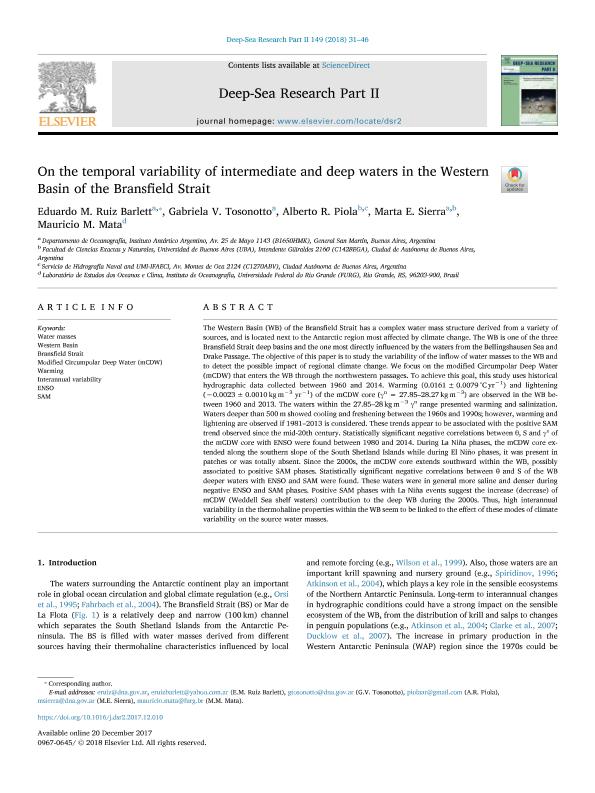Artículo
On the temporal variability of intermediate and deep waters in the Western Basin of the Bransfield Strait
Ruiz Barlett, Eduardo Mariano; Tosonotto, Gabriela V.; Piola, Alberto Ricardo ; Sierra, Marta E.; Mata, Mauricio M.
; Sierra, Marta E.; Mata, Mauricio M.
 ; Sierra, Marta E.; Mata, Mauricio M.
; Sierra, Marta E.; Mata, Mauricio M.
Fecha de publicación:
03/2018
Editorial:
Pergamon-Elsevier Science Ltd
Revista:
Deep Sea Research Part II: Topical Studies in Oceanography
ISSN:
0967-0645
Idioma:
Inglés
Tipo de recurso:
Artículo publicado
Clasificación temática:
Resumen
The Western Basin (WB) of the Bransfield Strait has a complex water mass structure derived from a variety of sources, and is located next to the Antarctic region most affected by climate change. The WB is one of the three Bransfield Strait deep basins and the one most directly influenced by the waters from the Bellingshausen Sea and Drake Passage. The objective of this paper is to study the variability of the inflow of water masses to the WB and to detect the possible impact of regional climate change. We focus on the modified Circumpolar Deep Water (mCDW) that enters the WB through the northwestern passages. To achieve this goal, this study uses historical hydrographic data collected between 1960 and 2014. Warming (0.0161 ± 0.0079 °C yr−1) and lightening (−0.0023 ± 0.0010 kg m−3 yr−1) of the mCDW core (γn = 27.85–28.27 kg m−3) are observed in the WB between 1960 and 2013. The waters within the 27.85–28 kg m−3 γn range presented warming and salinization. Waters deeper than 500 m showed cooling and freshening between the 1960s and 1990s; however, warming and lightening are observed if 1981–2013 is considered. These trends appear to be associated with the positive SAM trend observed since the mid-20th century. Statistically significant negative correlations between θ S and γⁿ of the mCDW core with ENSO were found between 1980 and 2014. During La Niña phases, the mCDW core extended along the southern slope of the South Shetland Islands while during El Niño phases, it was present in patches or was totally absent. Since the 2000s, the mCDW core extends southward within the WB, possibly associated to positive SAM phases. Statistically significant negative correlations between θ and S of the WB deeper waters with ENSO and SAM were found. These waters were in general more saline and denser during negative ENSO and SAM phases. Positive SAM phases with La Niña events suggest the increase (decrease) of mCDW (Weddell Sea shelf waters) contribution to the deep WB during the 2000s. Thus, high interannual variability in the thermohaline properties within the WB seem to be linked to the effect of these modes of climate variability on the source water masses.
Archivos asociados
Licencia
Identificadores
Colecciones
Articulos(SEDE CENTRAL)
Articulos de SEDE CENTRAL
Articulos de SEDE CENTRAL
Citación
Ruiz Barlett, Eduardo Mariano; Tosonotto, Gabriela V.; Piola, Alberto Ricardo; Sierra, Marta E.; Mata, Mauricio M.; On the temporal variability of intermediate and deep waters in the Western Basin of the Bransfield Strait; Pergamon-Elsevier Science Ltd; Deep Sea Research Part II: Topical Studies in Oceanography; 149; 3-2018; 31-46
Compartir
Altmétricas



